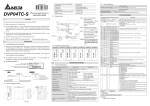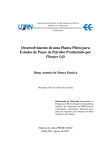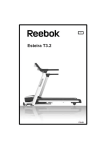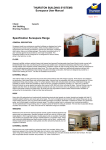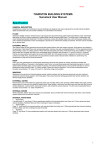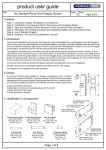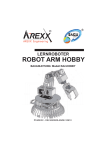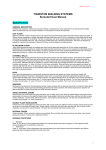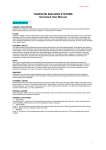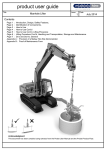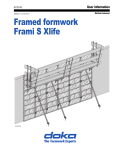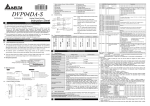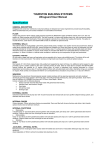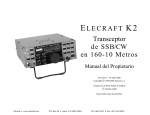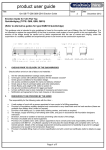Download Shaftbrace User Guide page 1 red
Transcript
product user guide Title Issue Shaftbrace 1 Date February 2013 Contents Page 1 Page 2 - 4 Page 5 Page 6 Page 7 - 8 Page 9 Page 10 Page 11 Page 12 Appendix A : : : : : : : : : : Introduction, Design, Frame Dimensions, Hydraulic Adjustments General Guidance Notes Identification of Components Typical Waling Assembly and Site Connection Details Typical Sequence of Sheet and Frame Installation Removal of Frames, Use of Restraint Chains (SHBP-189) Capacity 2.0T Frame Dimensions and Leg Weights Mechanical Pump Details and Procedures for Extending / Retracting Walings Do’s and Don’ts, General Provision of a Mabey Hire Site Demonstrator 1. Introduction Mabey Hire’s Shaftbrace system is intended to be used as a temporary waling system to sheeted excavations. It is not intended for other purposes. The product is frequently used in combination with: • Super Shaftbrace waling system. • Hydraulic bracing strut. • Mechanical bracing strut. • Double Acting Manhole Brace. For details of these waling systems and bracing struts within Mabey Hire’s range, refer to the appropriate set of user information. This booklet provides basic information for users of Shaftbrace to assist them in their preparation of a safe system of work on site. Shaftbrace should NOT be used in seawater applications without prior consultation with Mabey Hire. Refer to Appendix A for details of our site demonstrator service. 2. Design No information on design is included in this booklet. Clients are strongly advised to ensure that a competent engineer is employed to provide a suitable design for excavation schemes requiring the use of Shaftbrace products. Mabey Hire Ltd offer a design service and can, on request, also provide information on the strength capacities of Shaftbrace products for clients undertaking their own designs. 3. Frame Dimensions This booklet gives information for frame dimensions for Shaftbrace Walings. When Shaftbrace is used in combination with Super Shaftbrace or Double Acting Manhole Brace consult Mabey Hire staff for frame dimensions. 4. Hydraulic Adjustments The Shaftbrace system incorporates a hydraulic system of adjustment which is designed to extend or retract the frames under conditions of no or low loading: e.g. as when first installed or as they become redundant after backfilling the excavation. Once they are sustaining significant ground loads, hydraulic extension or retraction of the frames is inadvisable and is unlikely to be possible. Methods of working should therefore avoid the need for frame adjustment / removal whilst the walings are heavily loaded. Page 1 of 12 product user guide Title Issue Shaftbrace 1 Date February 2013 5. General Guidance Notes 5.1 Safe System of Work and Method Statement Assuming that the location, plan size and depth of an excavation, together with an arrangement of sheets and frames has already been determined, the Health and Safety at Work Act requires that a safe system of work is adopted to carry out the work on site. These guidance notes are intended to draw the client's attention to practical aspects of Shaftbrace installation which need to be considered in compiling method statements for a safe system of work. In particular, the client's attention is drawn to the lengths and weights of the frame members and the need for planning the lifting operations involved. All major components of the Shaftbrace system are fitted with lifting lugs for safe slinging. Two methods of constructing a typical excavation using Shaftbrace are given on Pages 7 - 8. 5.2 Manpower The Health and Safety legislation requires that personnel deployed are suitably trained, experienced and supervised by a competent person. All lifting operations are to be controlled by an appointed person in accordance with BS7121 and LOLER regulations. The main activities associated with Shaftbrace installation are: • Unloading the delivery vehicle. • Bolting up and pinning steelwork together to form walings of the required length. • Slinging and lifting walings into position in the excavation, and connecting the corners to form frames. • Connecting the pump to each waling in turn, pressurizing the frames and fitting restraint chains. 5.3 Plant and Lifting A suitable appliance is required for off-loading and installation. For off-loading there needs to be sufficient clearance under the main hook to allow lifting with a safe angle between the lifting slings. If the walings are to be lifted into the excavation then the appliance should be located a safe distance from the edge of the excavation and the lifts and radii checked against the safe lifting capacities of the appliance. In this booklet it is assumed that the frames will be lifted into the excavation one leg at a time and assembled in the excavation. Likewise for removal it is assumed that the frame will be dismantled in the excavation and the legs removed one at a time. WARNING : If an excavator is being used for lifting operations, refer to safety information on page 4. 5.4 Small Plant, Tools and Lifting Chains for Handling Essential equipment required is: 5.4.1 A compressor with 100 p.s.i. output and sufficient length of air line to power the pump. The pump is fitted with a standard 1/2" BSP air hose claw connector. 5.4.2 Sledgehammers for making pinned connections. (Not in Mabey Hire Supply). 5.4.3 Podgers/spanners for making bolted connections. (Bolt sizes are M20 for walings and M16 for struts). These are normally supplied with Mabey Hire's installation kit. 5.4.4 Lifting chains of suitable length and capacity and with current certification. The walings have lifting lugs designed to take 10mm safety hooks. 5.4.5 In most cases the centre of gravity of the lifts involved will not be at mid-length so shortening clutches are advisable. Mabey Hire offer sets of 4 leg chains with 4.0m leg length c/w shortening clutches and safety hooks (Code : SB-LSLG/SH, weight 47kg, SWL 9.0 tons @ 90O) though clients should check that the leg length is suitable to use with their lifting appliance. 5.5 Edge Protection, Access and Hard Standing Areas These include:• Suitable area to off-load the lorry and assemble the walings. • Suitable hard standings for the lifting appliance to operate from if it is intended to lift the walings into the excavation. • Ladders and possibly other provisions to provide safe access into the excavation to install restraint chains and connect pump hoses. • Edge protection, ladders and possibly other provisions to provide safe access into and out of the excavation. (Edge protection and ladder access platforms can be supplied by Mabey Hire Ltd). Page 2 of 12 product user guide Title Issue Shaftbrace 1 Date February 2013 5.6 During Excavation Works on Site If Mabey Hire Ltd have designed the sheeting and frame arrangement for the excavation they will have used ground data provided by the client. If during the excavation it is noted that the actual ground conditions and / or ground water levels differ from those provided at design stage it is advisable to have the scheme rechecked. 5.7 After Excavation Works are Completed Plan for edge protection to be installed as early as possible. Regularly inspect the excavation for signs of excessive movements of sheets or walings. Check the hydraulic walings for signs of fluid leakage. Keep plant, spoil heaps and stored materials well clear from the edge of the excavation. 5.8 Return of Equipment off Hire Clients should ensure that on removal, the equipment is returned clean in lengths as supplied. 5.9 Transportation Ensure all equipment is loaded to the satisfaction of the lorry driver and is securely chained / strapped to the lorry. 5.10 References 5.10.1 Legislation The Health & Safety at Work Act 1974 The Management of Health and Safety at Work Regs (M.H.S.W.) 1999 The Construction (Design and Management ) Regulations 2007 The Control of Substances Hazardous to Health (COSHH) Regulations 1994 The Lifting Operations and Lifting Equipment Regulations (LOLER) 1998 The Provision and Use of Work Equipment Regulations (PUWER) 1998 Work at Height Regulations 2005 Noise Manual Handling 5.10.2 HSE Guidance Health and Safety in Construction (HSG150 - rev) A Guide to Managing Health and Safety in Construction (ISBN 0 7176 0755 0) Health and Safety in Excavations - Be Safe and Shore (HSG185) Safe Work in Confined Spaces - Regulations, Approved Code of Practice and Guidance (L101) Five Steps to Risk Assessment (INDG 163) Excavators Used as Cranes - Guidance Note PM42 5.10.3 Other Guidance CPA Guidance Safety in Shoring - The Proprietary Shoring and Piling Equipment Manual CPA (STIG) Guidance STIG 0201 : Selection of Proprietary Shoring Equipment CPA (STIG) Guidance TIN 203 : The Use of Restraining Chains to Support Shoring Equipment CPA (STIG) Guidance TIN 204 : The Correct Use of Lifting and Other Attachment Points for Shoring Equipment CPA Safety Guidance Risk Assessment (SG 003) CPA Guide Ref No. SG001(3) Guidance on Lifting Operations in Construction When Using Excavators CIRIA Report R166 CDM Regulations - Work Sector Guidance for Designers Trenching Practice CIRIA Report 97 Crane Stability on Site CIRIA Special Publication 131 The Design and Construction of Sheet-Piled Cofferdams CIRIA Special Publication 95 5.10.4 British and European Standards BS 6031 : 2009 Code of Practice for Earthworks BS EN 996 : 1996 Piling Equipment. Safety Requirements BS EN 1997-1 : 2004 Code of Practice for Foundations BS 5228-1 : 2009 Code of Practice for Noise and Vibration Control on Construction and Open Sites : Noise BS 5228-2 : 2009 Code of Practice for Noise and Vibration Control on Construction and Open Sites : Vibration Page 3 of 12 product user guide Title Issue Shaftbrace 1 Date February 2013 6. Sling Warning Code : SSBA-007 Refer to product user guide for further details. Page 4 of 12 product user guide Title Date Issue Shaftbrace 1 February 2013 7. Identification of Components Ram Unit Male Male Female Male Intermediate Extension (203 x 203 U.C.) Female ‘L’ ‘L’ Pin to Pin ’L’ mm Code Min Max Weight (Kg) SHBP-110 1455 2055 270 SHBP-100 1855 2855 355 Code Pin to Pin ’L’ mm Weight (Kg) SHBP-170 500 60 SHBP-157 750 68 SHBP-158 1000 79 SHBP-154 1500 115 SHBP-155 2000 145 SHBP-188 2500 173 SHBP-156 3000 200 SHBP-161 4500 270 SHBP-177 5000 295 SHBP-162 7000 420 End Extension (203 x 203 U.C.) Female ‘L’ Code Pin to Pin ’L’ mm Weight (Kg) SHBP-193 550 81 SHBP-150 1000 102 SHBP-151 1500 128 SHBP-174 2000 156 SHBP-152 2500 183 SHBP-153 3500 238 135 Degree Corner Unit Male Male End Extension (203 x 203 U.C.) Male Female Female 135 o Code Dimension ‘L’ mm Weight (Kg) SHBP-201 790 111 ‘L’ Code SHBP-195 ‘L’ ‘L’ Pin to Pin ‘L’mm Weight (Kg) 450 50 Male Heavy Duty Intermediate Extension (254 x 254 U.C.) Female ‘L’ Code Pin to Pin ’L’ mm Weight (Kg) SHBP-187 500 88 SHBP-182 750 115 SHBP-171 1000 140 SHBP-168 1500 195 SHBP-172 2000 240 SHBP-169 3000 350 SHBP-186 4000 470 Code Pin to Pin ’L’ mm Weight (Kg) SHBP-178 5000 570 SHBP-192 7250 807 SHBP-183 8700 965 SHBP-167 9000 975 SHBP-184 10200 1125 SHBP-163 10500 1150 SHBP-166 12000 1460 7.1 Accessories • Installation Kit : Double Acting Pump, Code : MHB-100 or PSP-101, Weight : 18 Kg empty, 43 Kg full. Hose Extensions, Code : PSP-275. Lock-off valve spanner. • Lifting Chain, Code : SB-LSLG/SH, Weight : 47 Kg, 10mm 4 leg chain sling, 4m E.L.L. c/w 4 No. Safety Hooks and 4 No. shortening Clutches. Refer to Lifting Chain User Information for further details. • Restraint Chain (Code SHBP-189), Weight 5.8Kg. 2m E.L.L. Capacity 3200Kg. Note: When used in combination with Mabey Hire M11 sheets capacity reduces to 1500Kg. (See also Page 9). Page 5 of 12 product user guide Title Issue Shaftbrace 1 Date February 2012 8. Typical Waling Assembly and Site Connection Details 100 Ram section 2 Sizes (See page 5) Box Section Intermediate Extension Various lengths (See Page 5) 203 x 203 UC End Extension 100 Various lengths (See page 5) 2 No. 20mm O bolts x75mm long. 1 No. Bailey pin (48mm O) c/w spring retention clip 8.1 Assembly The legs of the brace are made to the correct length range where possible prior to delivery, so that only the corners need be connected using a Bailey pin complete with spring retention clip as supplied. The lug is a close fit in the clevis, so that the legs should be as level as possible during assembly to make it easier to assemble the joint. It is worth spending some time on levelling the ground on which the frame is to be assembled. If the legs have to be altered to another range on site, i.e. by adding or removing an extension section, the intermediate connection detail is used. This consists of 1 No. Bailey pin and spring retention clip and two M20 x 75mm long bolts. IMPORTANT ! Before lifting each leg into the excavation: 1. Ensure that 1 No. Bailey pin and 2 No. M20 bolts are fitted at each intermediate connection. 2. Ensure that the spring clips are fitted and that the bolts are fully tightened. 8.2 Site Connections for Waling 1 No. Bailey Pin (48mm O) 1 No. Bailey Pin (48mm O) 2 No. M20 Bolts x 75mm Long Ram Unit End Extension Intermediate or End Extension Intermediate Extension 1 No. Spring Retention Clip 1 No. Spring Retention Clip Corner Connection Intermediate Connection Extensions are normally attached where possible prior to delivery, but to suit site conditions, the extensions can be changed by unbolting the 2 bolts and removing the Bailey pin. Page 6 of 12 product user guide Title Issue Shaftbrace 1 Date February 2013 9. Typical Sequence of Sheet and Frame Installation 9.1 Method 1 : Installation of 2 frames by excavator, without piling hammer, placing one leg at a time. WARNING : Refer to safety information on page 4 regarding excavators being used for lifting operations. 1. Fully excavate to first frame level. 1b. Alternatively excavate slit trench only to first frame level. 2. Place each leg in excavation and assemble the frame. Connect hydraulics and pump frame out to correct dimension. Remove hydraulics. 3 Using the frame and excavated face as a guide, place sheets and using the relevant drive cap drive with excavator bucket as far as possible. 4. Connect restraint chains as per scheme drawing. 5. Connect hydraulics and individually pressurise all frame ram units to 2500 p.s.i., close lock-off valves and remove hydraulics. 6. Dig through to next frame position and push sheets down. 7. Reposition restraint chains as necessary. 8. Place legs of second frame in excavation and assemble (safe working must be maintained). 9. Attach restraint chains between second frame and the top of the sheets / piling. 10. Connect hydraulics and individually pressurise all lower frame ram units to 2500 p.s.i., close lock-off valves and remove hydraulics. 11. Push sheets down to give “toe-in” required and complete dig. NOTE : 1. This method requires operatives working in the excavation and the contractor must ensure safe working conditions at all times. 2. See Page 9 for notes on use of restraint chains. Page 7 of 12 product user guide Title Issue Shaftbrace 1 Date February 2013 9.2 Method 2 : Installation of 2 frames by crane and excavator, fully driving sheets / piling with piling hammer. Use the crane for lifting and driving operations and the excavator for digging operations. 1. Fully drive sheets/piling using a piling hammer. 2. Remove piling guide and excavate to first frame level. 3. Weld angle brackets to the piling if required to support the frame. 4. Place each leg in excavation and assemble the frame. 5. Connect restraint chains. 6. Connect hydraulics and individually pressurise all ram units to 2500 p.s.i., close lock-off valve and remove hydraulics. 7. Dig through to next frame position. 8. Weld angle brackets to the piling if required to support the frame. 9. Place legs of second frame in excavation and assemble (safe working must be maintained). 10. Attach restraint chains between second frame and the top of the sheets/piling. 11. Connect hydraulics and individually pressurise all lower ram units to 2500 p.s.i., close lock-off valve and remove hydraulics. 12. Complete dig. NOTE : 1. This method requires operatives working in the excavation and the contractor must ensure safe working conditions at all times. 2. See Page 9 for notes on use of restraint chains. Page 8 of 12 product user guide Title Issue Shaftbrace 1 Date February 2013 10. Removal of Frames Backfill to the underside of the lowest frame and carry out any compaction required. Ensure frame is securely packed or supported from below. Connect hydraulics and individually open lock-off valves (max 2 turns) and fully retract all lower frame ram units. Remove restraint chains. Remove corner pins, attach lifting sling to lifting eyes and lift each leg one at a time from excavation. Follow the above procedure for the upper frame. When the frames have been removed and the excavation backfilled, the sheets can be removed, one at a time using a trench sheet extractor. 11. Use of Restraint Chains (SHBP-189) Capacity 2.0T * Restraint chains are provided as a back-up support arrangement in the unlikely event of hydraulic failure of one of the Shaftbrace hydraulic legs. They are NOT to be used for any other purpose and particularly, are NOT to be used as lifting chains. They are NOT intended as a means of suspension to be relied upon during installation or removal of the frames. Always ensure all the restraint chains are fitted as per arrangement shown on the scheme drawing, or if no scheme has been prepared 1 No. chain every 2.5 m approx of waling. Remove as much slack as possible from the chain by repositioning the lower ‘D’ shackle. Users must ensure that frames are securely supported by means other than the restraint chains prior to depressurizing the frames. Forged hook for hanging over top of sheets Chain ‘D’ Shackle ‘D’ Shackle * NOTE : When used with Mabey Hire M11 sheets Restraint Chain capacity reduces to 1.5T. When used with M6 / M7 sheets capacity reduces to 1000 Kg. Page 9 of 12 product user guide Title Issue Shaftbrace 1 Date February 2012 12. Frame Dimensions and Leg Weights Clear Internal Sheet to Sheet Approx. Max Leg Dimensions Deflection Dimensions (mm) per Waling Weight (mm) (kg) Min. Max. (mm) Min. Max. Leg Code Leg Arrangement SHBL-00 SHBP-100 + SHBP-162 8705 9705 9205 10205 333 775 SHBL-01 SHBP-100 + SHBP-156 + SHBP-153 8105 9105 8605 9605 314 792 SHBL-02 SHBP-100 + SHBP-154 + SHBP-155 + SHBP-152 7605 8605 8105 9105 297 798 SHBL-03 SHBP-100 + SHBP-155 + SHBP-153 7105 8105 7605 8605 280 737 SHBL-04 SHBP-100 + SHBP-154 + SHBP-153 6605 7605 7105 8105 264 707 SHBL-05 SHBP-100 + SHBP-156 + SHBP-151 6105 7105 6605 7605 247 683 SHBL-06 SHBP-100 + SHBP-154 + SHBP-152 5605 6605 6105 7105 230 653 SHBL-07 SHBP-100 + SHBP-153 5105 6105 5605 6605 214 592 SHBL-08 SHBP-100 + SHBP-154 + SHBP-151 4605 5605 5105 6105 197 599 SHBL-09 SHBP-100 + SHBP-152 4105 5105 4605 5605 180 538 SHBL-09A* SHBP-100 + SHBP-155 3605 4605 4105 5105 164 500 SHBL-10 SHBP-100 + SHBP-151 3105 4105 3605 4605 147 483 SHBL-11 SHBP-100 + SHBP-150 2605 3605 3105 4105 130 455 SHBL-11A* SHBP-100 + SHBP-157 2455 3455 2955 3955 125 423 SHBL-11B* SHBP-100 + SHBP-170 2205 3205 2705 3705 117 411 SHBL-12* SHBP-100 (1m stroke = 1.855m to 2.855m) 1705 2705 2205 3205 100 355 SHBL-13* SHBP-110 (0.6m stroke = 1.455m to 2.055m) 1305 1905 1805 2405 74 270 NOTES: * These legs only use intermediate extensions. • If intermediate extensions are used in place of end extensions add :100mm to Clear Inside dimension. 100mm to Face of Sheet dimension. • All legs use the SHBP-100 Ram Unit except SHBL-13 • Leg lengths over 7.0m may require bracing struts. • Frame sizes for other combinations can be supplied by Mabey Hire Limited on request. • The clear internal dimensions tabulated do not include any allowance for deflection of the walings under load. • These waling deflections are listed separately above and generally it will be necessary to increase the clear internal dimensions by twice the appropriate waling deflection. Page 10 of 12 product user guide Title Issue Shaftbrace 1 Date February 2013 13. Mechanical Pump Details and Procedures for Extending / Retracting Walings 13.1 Introduction It is advisable before commencing installation to read the notes below to become familiar with the procedures involved. The diagram below shows the pump control lever, gauge, hose connections and safety lock-off valve referred to in the procedures. Pump lever set to retract Pump lever set to neutral Retract Extend EXTEND RETRACT EXTEND EXTEND RETRACT Pump Control Lever (See detail to left) Gauge Pump lever set to extend EXTEND Safety Lock-Off Valve RETRACT RETRACT Handle PSP-101 Pump Female Connector (Retract) Shaftbrace Ram Unit Male Connector (Extend) 13.2 Preliminaries • Check there is sufficient of the correct Mabey Hire shoring fluid in the tank. Only Mabey shoring fluid should be used. • Set the pump control lever to "Neutral". • Purge the hoses of air. To do this, connect the hoses together and pump for several strokes with the pump control lever set to "Extend". When satisfied that any air has been expelled, set the pump control valve to "Neutral". 13.3 Mabey Hire Shoring Fluid The pump is normally supplied with a full tank of pre-mixed fluid. If the fluid is separately supplied "neat" in 5 litre orange coloured containers, it should be poured into the pump and cold clean water added according to prevailing temperature conditions. (See table right). Protective gloves should always be worn when handling shoring fluid. NOTE : A Shoring Fluid safety data sheet is available from Mabey Hire Limited. Temp Range Shoring Fluid Water (C) (litres) (litres) Above 0 5 20 -6 to 0 10 20 -10 to -7 15 15 -10 and below Neat fluid only 13.4 Procedure for extending walings to predetermined lengths - or pressurizing a frame. • Ensure each waling is set up level and safely on packs just clear of the ground so that it will be free to extend. • Connect both hoses as per the diagram. • Set the pump control lever to ‘Extend’. • Ensure that safety lock-off valve on the ram is open by turning anti-clockwise no more than 2 turns. • Pump to required size. If the ram does not move, refer to fault finding (section 13.6). If necessary the frame can also be pressurized by continuing to pump. The pump will develop a pressure of 2500 p.s.i. before cutting out, corresponding to a load of about 6 tons. • Close safety lock-off valve with tool provided - hand pressure is sufficient. • Move pump control lever between extend and retract a few times. This relieves pressure on the couplers and allows easy removal and replacement of the hoses. • Remove hoses. • Repeat the above steps for each waling of the frame in turn. Page 11 of 12 product user guide Title Issue Shaftbrace 1 Date February 2013 13.5 • • • • Procedure for releasing walings and retraction Ensure the waling is secured against dropping before setting about releasing. Set the pump control lever to "Neutral". Connect the pump hoses to the ram unit of the waling. Slowly open the safety lock-off valve to release the hydraulic fluid pressure and allow fluid to flow back through the pump. • To release frames, it will be necessary to retract the walings in turn by setting the pump control valve to "Retract" and operating the pump until the ram is fully retracted. • On completion of retraction set the pump control valve to "Neutral". • Close lock-off valve in ram unit and disconnect pump hoses from the ram. 13.6 Fault Finding In the event of the frames not extending or retracting when pumped, check the following points: • Pump is adequately filled with fluid. • Pump Control Lever is in the correct position for required operation. • Both hoses are connected - double check connections to the couplers on the ram. • Safety lock-off valve is open (rotated anti-clockwise - max. 2 turns). • Frame is not heavily loaded. If the ram still does not move, there may be air in the system which may be indicated by the ram springing back, and this must be purged as follows: • To purge pump - disconnect hoses from ram and connect hose ends together. Pump for several strokes until fluid can be heard returning to the tank. Repeat with lever in opposite position. • To purge ram - connect hoses, and pump ram to full extension. Reverse lever and pump until fully closed. Repeat until there is no sign of ram springing back. If the ram still does not function properly refer to your nearest depot. 14. Do’s and Don’ts DO install the legs of each frame one at a time. DO install frames as level as possible. DO use restraint chains between each frame to the top of the sheets. DO ensure the lock-off valves are open prior to pumping. DO ensure that the pressure is being held on the rams before closing the lock-off valves. DO release the pump pressure after closing the lock-off valves to ease removal of hoses. DO keep the couplers of the hoses dirt free by clipping male and female ends together after use. DO NOT attempt to install or remove by lifting complete frames. DO NOT over pressurise the system as this can damage the rails. DO NOT pressurise a frame with a large gap between the rails and the sheets. A packer must be inserted to fill the gap first. DO NOT attempt to disconnect a hose until the lock-off valve has been fully closed, and pressure has been released at the pump. DO NOT release ram pressure by depressing or striking the coupler nipple. DO NOT use restraint chains as a means of suspension during installation or removal of the frames. 15. General Since our policy is one of continual improvement, components may vary in detail from the descriptions given in this publication. Page 12 of 12














